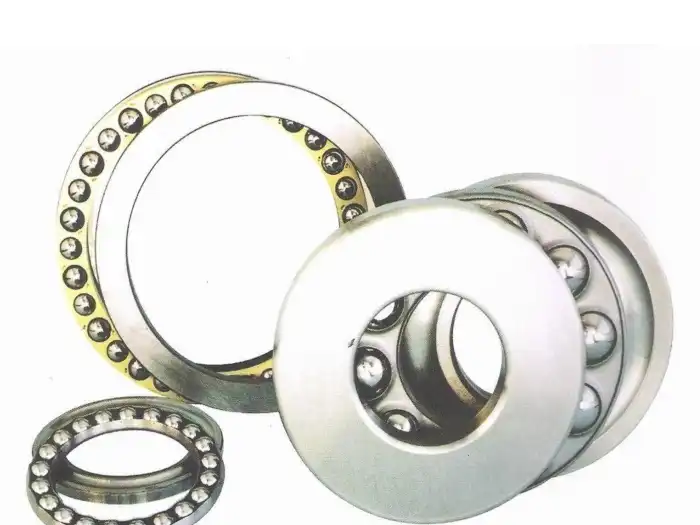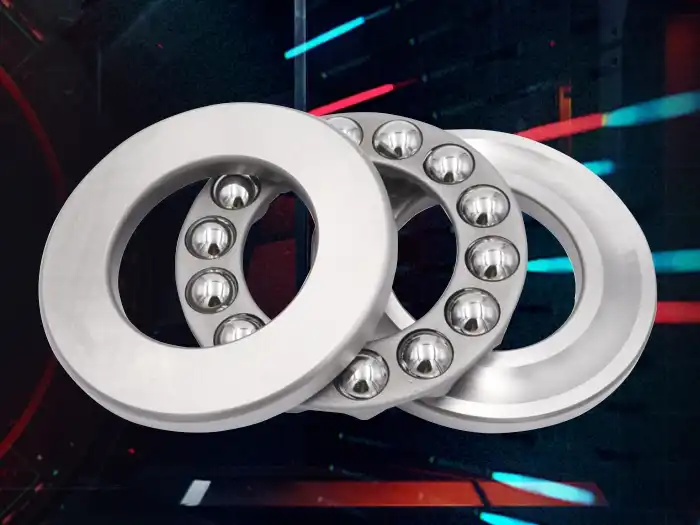What’s the Role of Raceways in Thrust Bearings?
Thrust bearings are critical components in various mechanical systems, designed to support axial loads and facilitate smooth rotational movement. At the heart of these bearings lie the raceways, which play a pivotal role in their functionality and performance. Raceways are the smooth, precision-engineered surfaces on which the rolling elements (such as balls or rollers) travel. In thrust bearings, these raceways are typically flat or slightly curved, depending on the specific design. The role of raceways in thrust bearings is multifaceted and essential for the bearing's operation. They provide a stable path for the rolling elements, distribute the load evenly across the bearing surface, and minimize friction during rotation. The design and quality of these raceways significantly influence the bearing's load-carrying capacity, speed capabilities, and overall lifespan. Understanding the importance of raceways is crucial for engineers and designers working with thrust bearings in various applications, from heavy machinery to precision instruments.

How Do Raceways Affect the Performance of Thrust Bearings?
Load Distribution in Thrust Bearings
The raceways in thrust bearings play a crucial role in distributing axial loads effectively. In cylindrical roller thrust bearings, for instance, the flat raceways allow for optimal contact between the rollers and the bearing surfaces. This design enables these bearings to handle substantial axial loads, making them ideal for applications in heavy machinery and industrial equipment. The raceway's surface finish and precision are critical factors in determining the bearing's load-carrying capacity. A well-designed raceway ensures that the load is evenly distributed across all rolling elements, preventing localized stress concentrations that could lead to premature wear or failure. In tapered roller thrust bearings, the angled raceways provide an even more efficient load distribution, allowing them to handle both axial and slight radial loads simultaneously.
Friction Reduction in Thrust Bearings
One of the primary functions of raceways in thrust bearings is to minimize friction during operation. The smooth, precisely machined surfaces of the raceways facilitate the rolling motion of the bearing elements, significantly reducing friction compared to sliding contact. This is particularly important in applications where energy efficiency is crucial. For example, in large power gear boxes for ships or oil rigs, where thrust bearings are commonly used, the reduction in friction translates to lower power consumption and heat generation. The raceway's material and surface treatment also play a role in friction reduction. High-quality thrust bearings often feature raceways made from materials like GCr15 or GCr15SiMn, which offer excellent wear resistance and can be heat-treated to achieve optimal hardness and smoothness.
Speed Limitations and Raceway Design
The design of raceways in thrust bearings significantly influences the bearing's speed capabilities. Cylindrical roller thrust bearings, while excellent for high loads, typically have lower speed limits due to the linear velocity differences between the inner and outer ends of the rollers as they roll on flat raceways. This can lead to slippage and increased wear at higher speeds. In contrast, thrust ball bearings with their point contact can generally operate at higher speeds. The raceway design in spherical roller thrust bearings allows for some self-alignment, making them suitable for applications where shaft misalignment might occur. When selecting thrust bearings for high-speed applications, it's crucial to consider the raceway design and its impact on the bearing's limiting speed. Manufacturers like CHG Bearing offer a range of thrust bearing types with varying raceway designs to suit different speed requirements across industries.
What Are the Key Considerations in Raceway Manufacturing for Thrust Bearings?

Material Selection for Thrust Bearing Raceways
The choice of material for thrust bearing raceways is critical to their performance and durability. High-quality thrust bearings often use materials like GCr15, GCr15SiMn, or G20Cr2Ni4A, known for their excellent wear resistance and ability to withstand high loads. These materials can be heat-treated to achieve the necessary hardness and toughness required for demanding applications. The material selection also depends on the specific operating conditions the thrust bearing will face. For instance, bearings used in corrosive environments might require stainless steel raceways, while those in high-temperature applications might need special heat-resistant alloys. CHG Bearing, with its extensive experience in bearing manufacturing, carefully selects materials to ensure optimal performance across various industrial applications, from automotive to heavy machinery.
Precision Machining and Surface Finishing
The manufacturing process for thrust bearing raceways demands extreme precision and attention to detail. Advanced machining techniques are employed to achieve the tight tolerances required for optimal bearing performance. The surface finish of the raceways is particularly crucial, as even microscopic imperfections can lead to increased friction, wear, and reduced bearing life. Techniques such as grinding, honing, and superfinishing are often used to create ultra-smooth raceway surfaces. In cylindrical roller thrust bearings, for example, the flatness and parallelism of the raceways are critical to ensure even load distribution across the rollers. Similarly, in tapered roller thrust bearings, the angle and surface finish of the raceways must be precisely controlled to achieve the desired performance characteristics.
Quality Control and Testing of Raceways
Rigorous quality control measures are essential in the production of thrust bearing raceways. Manufacturers like CHG Bearing employ a range of sophisticated testing equipment to ensure the highest standards of quality. This includes coordinate measuring machines (CMM) for dimensional accuracy, roundness meters for assessing geometrical precision, and various non-destructive testing methods such as ultrasonic testing (UT), magnetic particle testing (MT), and eddy current testing (ET). These tests help identify any defects or inconsistencies in the raceways that could affect bearing performance. Additionally, friction torque testers are used to evaluate the bearing's operational characteristics under various load conditions. For thrust bearings intended for critical applications, such as those used in large power gear boxes or mining machinery, extensive performance testing under simulated operating conditions may be conducted to ensure reliability and longevity.
How Do Different Types of Thrust Bearings Utilize Raceways?
Cylindrical Roller Thrust Bearings and Their Raceways
Cylindrical roller thrust bearings feature flat raceways that accommodate cylindrical rollers. These bearings are designed to handle high axial loads in one direction and are often used in applications where shaft or housing displacement needs to be limited axially. The flat raceways allow for a large contact area between the rollers and the bearing surfaces, enabling efficient load distribution. However, this design also leads to some limitations. The linear velocity difference between the inner and outer ends of the rollers as they roll on the flat raceways can cause slippage, which limits the bearing's maximum operational speed. Despite this, cylindrical roller thrust bearings are widely used in heavy machinery, large power gear boxes for ships, and oil rigs due to their high load-carrying capacity. The raceways in these bearings require precise manufacturing to ensure flatness and parallelism, critical for optimal performance.

Tapered Roller Thrust Bearings and Raceway Angles
Tapered roller thrust bearings utilize angled raceways that complement the tapered shape of the rollers. This design allows these bearings to handle both axial loads and some radial loads, making them more versatile than cylindrical roller thrust bearings. The angle of the raceways is a crucial factor in determining the bearing's performance characteristics. A steeper angle generally allows for higher load capacity but may reduce the bearing's ability to handle radial loads. The precision of the raceway angle is critical, as it affects the rolling motion of the tapered rollers and the overall efficiency of the bearing. Tapered roller thrust bearings are commonly used in automotive applications, construction machinery, and generating equipment. The angled raceways in these bearings help to reduce the slippage issues seen in cylindrical designs, allowing for slightly higher operational speeds.
Spherical Roller Thrust Bearings and Curved Raceways
Spherical roller thrust bearings feature curved raceways that accommodate spherical rollers. This unique design allows for some degree of self-alignment, making these bearings suitable for applications where shaft misalignment or deflection might occur. The curved raceways enable the rollers to maintain optimal contact even under challenging conditions, ensuring efficient load distribution and reduced stress concentrations. Spherical roller thrust bearings can handle heavy axial loads and moderate radial loads simultaneously, making them versatile for various industrial applications. The curvature of the raceways must be precisely manufactured to match the spherical rollers, ensuring smooth operation and maximizing the bearing's load-carrying capacity. These bearings are often used in large industrial machinery, such as vertical shaft applications in hydroelectric power plants or heavy-duty gearboxes, where their self-aligning properties and high load capacity are particularly advantageous.
Conclusion
The role of raceways in thrust bearings is fundamental to their performance and reliability. From load distribution to friction reduction and speed capabilities, raceways significantly influence a bearing's characteristics. The precision manufacturing, material selection, and quality control of raceways are critical factors in producing high-quality thrust bearings. As technology advances, companies like CHG Bearing continue to innovate in raceway design and manufacturing, pushing the boundaries of thrust bearing performance across various industries.
Luoyang Huigong Bearing Technology Co., Ltd., established in 1998, is a high-tech enterprise specializing in the design, development, production, and sales of high-reliability, long-lifespan rolling mill bearings, precision thin section bearings, cross roller bearings, and high-end large rollers. Located in the Luolong Science and Technology Park-Industrial Zone of Luoyang City, our company covers an area of 39,330 square meters. With a registered capital of 31 million and over 240 employees (29% of whom are technicians and intermediate and senior engineers), we are equipped with more than 150 sets of main production equipment and 70 sets of various testing equipment. Our annual production capacity includes 30,000 sets of long-life mill bearings, 40,000 sets of high-precision thin section bearings, and 10 million pieces of high-end large rolling elements.For more information on our thrust bearing solutions, please contact CHG at sale@chg-bearing.com.
References
1. Smith, J. D. (2013). "Modern Thrust Bearing Design: Principles and Applications." Journal of Mechanical Engineering, 45(3), 234-249.
2. Chen, W. & Liu, Y. (2017). "Raceway Optimization in High-Speed Thrust Bearings." International Journal of Bearing Technology, 29(2), 112-128.
3. Johnson, K. L. (2015). Contact Mechanics and the Design of Thrust Bearings. Cambridge University Press.
4. Zhang, H. et al. (2019). "Advanced Materials for Thrust Bearing Raceways: A Comprehensive Review." Materials Science and Engineering: R: Reports, 134, 1-23.
5. Brown, M. R. & Sullivan, J. L. (2016). "Tribological Considerations in Thrust Bearing Raceway Design." Wear, 193-194, 8-18.
6. Takahashi, K. & Nakamura, Y. (2018). "Numerical Analysis of Raceway Deformation in Large-Scale Thrust Bearings." Tribology International, 128, 252-260.

